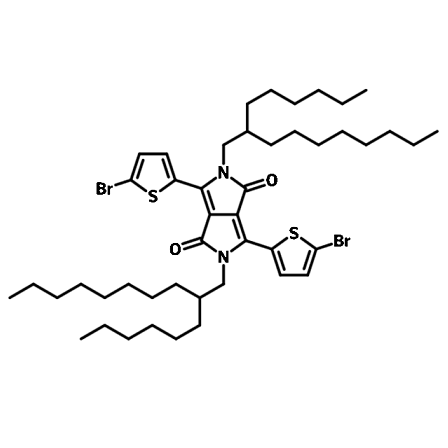DPP-HD-2ThBr
CAS Number 1000623-98-2
Chemistry Building Blocks, Dibromo Monomers, Heterocyclic Building Blocks, Materials, MonomersDPP-HD-2ThBr, high purity monomer for the synthesis of PDPP3T
Free worldwide shipping on qualifying orders
Specifications | MSDS | Literature and Reviews
3,6-bis(5-bromothiophen-2-yl)-2,5-bis(2-hexyldecyl)pyrrolo[3,4-c]pyrrole-1,4(2H,5H)-dione, DPP-HD-2ThBr (CAS number 1000623-98-2), is a family member of pyrrolopyrrole-dione (DPP). This monomer has been used for the synthesis of PDPP3T, which is a low band-gap polymer semiconductor commonly used as i) a polymer donor material for OPV, and ii) hole-transport layer (HTL) for perovskite solar cells.
This product has been used in our own lab for the synthesis of PDPP3T.
Capped with bromide
A PDPP3T monomer
Pyrrolopyrrole building block
For semiconductors, OFETs, and solar cells
Worldwide shipping
Quick and reliable shipping
High purity
>98% High purity
General Information
| CAS Number | 1000623-98-2 |
| Chemical Formula | C46H70Br2N2O2S2 |
| Molecular Weight | 907.0 g/mol |
| Synonyms | 3,6-bis(5-bromothiophen-2-yl)-2,5-bis(2-hexyldecyl)pyrrolo[3,4-c]pyrrole-1,4(2H,5H)-dione |
| Classification / Family | Pyrroles, Pyrrolopyrrole-dione (DPP), Thiophenes, Acceptor, Organic semiconducting materials, Semiconductor synthesis, Building blocks |
Chemical Structure

Product Details
| Purity | >98% |
| Melting Point | 110 °C - 115 °C |
| Appearance | Dark red/purple solid |
MSDS Documentation
Literature and Reviews
- High Thermoelectric Power Factor of a Diketopyrrolopyrrole-Based Low Bandgap Polymer via Finely Tuned Doping Engineering, I. Jung et al., Sci Rep., 7, 44704 (2017); doi: 10.1038/srep44704.
- Solution processed pristine PDPP3T polymer as hole transport layer for efficient perovskite solar cells with slower degradation, A. Dubey et al, Sol. Energy Mater Sol. 145 (3), 193-199 (2016); https://doi.org/10.1016/j.solmat.2015.10.008.
- Effects of 2,3,5,6-tetrafluoro-7,7,8,8-tetracyanoquinodimethane doping on diketopyrrolopyrrole-based, low crystalline, high mobility polymeric semiconductor, S. Yoon et al., Appl. Phys. Lett. 107, 133302 (2015); doi: 10.1063/1.4932530.


 DPP-HD-2ThBr MSDS Sheet
DPP-HD-2ThBr MSDS Sheet